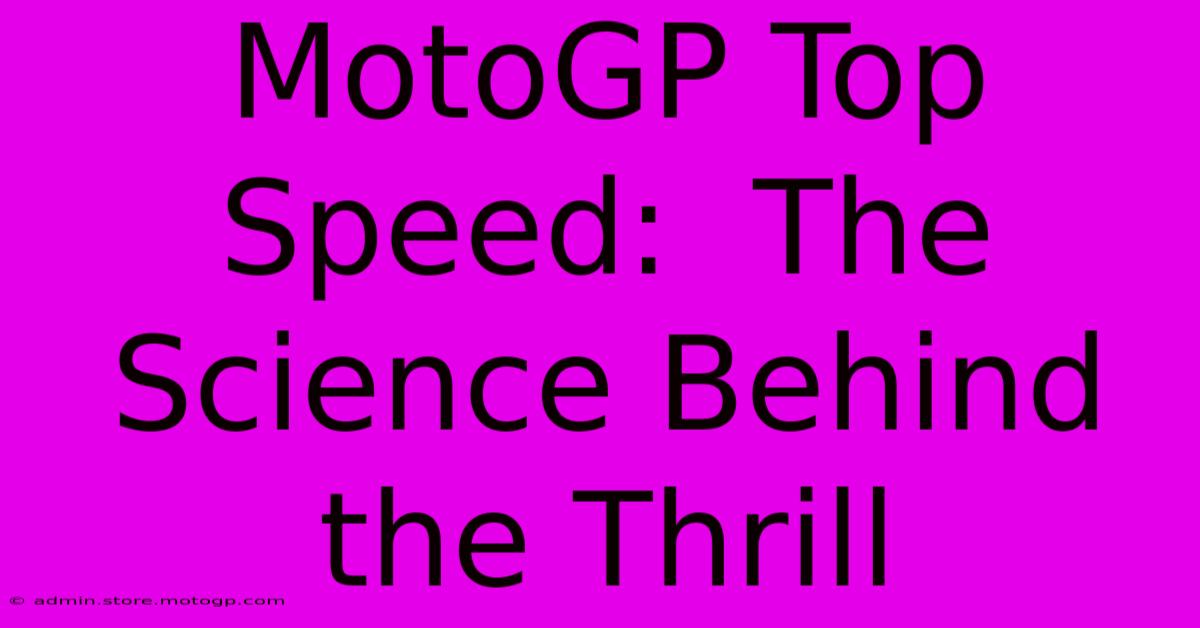MotoGP Top Speed: The Science Behind The Thrill

Table of Contents
MotoGP Top Speed: The Science Behind the Thrill
MotoGP. The name conjures images of screaming engines, blurred tire marks, and breathtaking speeds. But just how fast do these incredible machines really go? And what scientific principles make these phenomenal top speeds possible? Let's delve into the science behind the thrill of MotoGP's record-breaking velocities.
Understanding MotoGP's Top Speed
The top speed in MotoGP isn't a fixed number; it fluctuates based on several factors, including the specific track, weather conditions, and even the rider's skill. However, speeds consistently exceed 200 mph (320 km/h) on certain straights. Reaching these speeds is a complex interplay of engineering, aerodynamics, and rider expertise.
Factors Influencing Top Speed
-
Engine Power and Torque: MotoGP bikes boast incredibly powerful engines, typically exceeding 240 horsepower. This immense power, combined with optimal torque delivery, is crucial for rapid acceleration and achieving high top speeds. The finely tuned engines are a testament to years of research and development.
-
Aerodynamics: Aerodynamics plays a vital role. The sleek design of the bikes, including fairings and winglets, minimizes drag and maximizes downforce. These aerodynamic features allow the bike to slice through the air more efficiently, contributing significantly to its top speed. Engineers meticulously refine these features through wind tunnel testing and computational fluid dynamics (CFD) simulations.
-
Tire Grip and Traction: Even with immense power, the bike needs exceptional tire grip to translate that power into speed without wheelspin. Specialized MotoGP tires, constructed from advanced compounds and designed for optimal performance, provide the necessary traction for achieving and maintaining high speeds.
-
Rider Skill and Technique: A skilled rider knows how to maximize acceleration and maintain stability at high speeds. Their body position, throttle control, and braking techniques all contribute to the bike's overall performance.
The Physics of High-Speed Racing
Several physics principles are critical to understanding MotoGP top speeds:
Newton's Laws of Motion
-
Newton's First Law (Inertia): An object in motion tends to stay in motion unless acted upon by an external force. This is why maintaining high speeds requires overcoming air resistance and friction.
-
Newton's Second Law (F=ma): The acceleration of an object is directly proportional to the net force acting on it and inversely proportional to its mass. The powerful MotoGP engines generate the force needed for rapid acceleration.
-
Newton's Third Law (Action-Reaction): For every action, there's an equal and opposite reaction. The bike's engine pushes backward against the ground, and the ground pushes the bike forward.
Drag and Downforce
-
Drag: Air resistance (drag) acts as a significant force opposing the bike's motion. MotoGP bikes are engineered to minimize drag through streamlined design.
-
Downforce: Aerodynamic elements like winglets generate downforce, pressing the bike onto the track for improved stability and grip at high speeds. This allows for faster cornering and higher top speeds on straights.
Technological Advancements
Continuous advancements in engine technology, materials science, and aerodynamics push the boundaries of MotoGP top speeds. Lightweight materials like carbon fiber reduce the bike's mass, enabling quicker acceleration and higher top speeds. Innovations in tire technology also play a crucial role.
Conclusion
Reaching top speeds in MotoGP is a testament to the remarkable engineering prowess, the application of fundamental physics principles, and the skill of the riders. The pursuit of higher speeds drives continuous innovation, leading to ever-more exciting and record-breaking races. The science behind the thrill is a compelling mix of power, precision, and a relentless drive for perfection.

Thank you for visiting our website wich cover about MotoGP Top Speed: The Science Behind The Thrill. We hope the information provided has been useful to you. Feel free to contact us if you have any questions or need further assistance. See you next time and dont miss to bookmark.
Featured Posts
-
Cota Parking A Fans Guide
Feb 19, 2025
-
How Fast Is Moto Gp At Phillip Island
Feb 19, 2025
-
Cota Open Track Days Feel The G Force
Feb 19, 2025
-
Club Si Austin F1 Your All Access Pass To The Action
Feb 19, 2025
-
Moto Gp Aerodynamics The Science Behind The Spectacle
Feb 19, 2025
